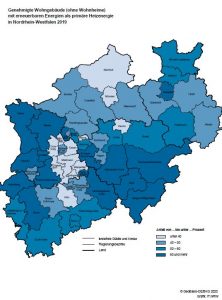
Concepts developed for urban areas
Berlin, 9 January 2020 - One of the Herculean tasks in achieving the climate targets is to radically reduce CO2 emissions from the heating supply. A research group led by the Institute for Ecological Economy Research (IÖW) is showing how cities can move away from coal, oil and gas in a socially responsible way. The "Urban Heat Transition" project analysed possible contributions from renewable energies and local heat sources in Berlin's urban districts. "Waste heat from businesses, heat from waste water or geothermal energy have hardly been utilised to date. The key to such environmentally friendly heat are neighbourhood concepts and heating networks," says project manager Bernd Hirschl from the IÖW. "An important prerequisite is a more efficient building stock. Only if the heat demand is significantly reduced can environmentally friendly heat sources be utilised efficiently."
In the three-year project, the project team from the IÖW, the University of Bremen and the Technical University of Berlin worked together with the Berlin Senate Department for the Environment, Transport and Climate Protection with funding from the Federal Ministry of Education and Research to develop local heating concepts for three Berlin neighbourhoods. At the end of 2019, they discussed their results with the heating industry in Berlin, and the documentation of the conference is now available online at www.urbane-waermewende.de.
Developing nuclei for the heat transition
"Previous neighbourhood concepts were often too complex, had too many different stakeholders and often ended up in a drawer. That's why we recommend a nucleus approach," says Elisa Dunkelberg from the IÖW. These could be public buildings, new construction projects, commercial buildings or housing associations and co-operatives.
The researchers show what a neighbourhood concept can look like for an old building district in Charlottenburg-Wilmersdorf: Firstly, the heat demand must be reduced through energy-efficient refurbishment. The heat can be generated using a wastewater heat pump, which is partly powered by solar electricity generated on site, in combination with combined heat and power generation. "Particularly in the case of public buildings, which have a pioneering role - enshrined in law in Berlin - it should always be checked in the case of refurbishment and new buildings whether they are suitable as a nucleus for a neighbourhood concept and the co-supply of surrounding buildings," emphasises Dunkelberg.
Climate-neutral district heating: utilising waste heat and renewables
District heating plays a major role in urban areas. "To become climate-neutral, it is important to integrate more local heat sources from wastewater, river water and geothermal energy as well as waste heat into district heating," says Hirschl, adding that attention must also be paid to the resilience of the heat generation system. A joint case study with the Neukölln district heating plant shows that it is possible to utilise local heat sources. But it needs to be tested technically and requires supporting financial measures. The next steps should now be test drilling for deep geothermal energy, for example, as well as pilot plants that use large heat pumps to provide wastewater or river water heat for district heating. Strategies for funding and risk protection are needed for investment in these technologies, some of which are untested and highly expensive.
Heat transition requires municipal strategic heat planning - and social compatibility
"Municipal heat planning, which has long been standard practice in pioneering countries such as Denmark and in other federal states and municipalities for some time, helps to tap into the identified potential," emphasises Hirschl. The basis for this is a heat register that visualises heat sources such as waste water and commercial waste heat. This can also be used to identify neighbourhoods for cross-building concepts. With sector coupling, it is also important that local authorities and cities plan across infrastructures. Instruments such as urban land-use planning and urban development contracts must be geared towards climate neutrality.
Low refurbishment rates in recent years show that purely incentive-based measures are not enough to ensure energy modernisation. The researchers therefore recommend implementing the regulations more strongly and developing a step-by-step plan to guide the building stock towards climate neutrality. At the same time, subsidies must be increased and conditions for passing on rent must be made more socially acceptable. A step-by-step plan under the conditions of a rent cap must be designed in such a way that energy modernisation is economically reasonable for both landlords and tenants.
Federal Ministry of Education and Research funds "Urban Heat Transition" project for another two years
The Federal Ministry of Education and Research is funding the project in a new partner constellation for a further two years in order to test solution strategies for the central obstacles to implementation and to anchor the research results in municipal heat planning. In addition to the IÖW, the partners are Berliner Wasserbetriebe and the law firm Becker Büttner Held.
Keywords: Stock, Blogs & Portals, CO2-neutral, DE-News, Renewable, Research, Climate protection, Quarters, Settlements, Solar thermal, Housing



